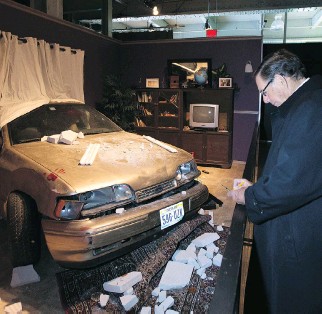If you have watched any police procedural show you have most certainly heard of IBIS, but did you know it was developed here in Montreal? I had no idea until I read this article (scroll down) in the Gazette by Bill Brownstein. —CPL
In the early 1990s, Forensic Technology, located atop a Montreal Urban Community police station across from the Cavendish Mall in Côte-St-Luc, created the groundbreaking, automated Integrated Ballistics Identification System, better known as IBIS.
From Wikipedia:
Automated firearms identification is now a universally accepted technology. As the system with the largest installed base, IBIS has become the de facto world standard.
The emergence of a world standard enables law enforcement agencies worldwide to share ballistic data. This capability is now being leveraged as a tool for international collaboration among law enforcement agencies worldwide. Countries have begun to link up their IBIS systems. Europe already has EURO-IBIS, while the United States recently concluded an agreement to link their NIBIN system with Canada’s.
INTERPOL
In early 2009, INTERPOL signed an agreement with Forensic Technology, wherein the latter will install and maintain an IBIS correlation server at INTERPOL headquarters in Lyon, France. To facilitate ballistic information sharing among INTERPOL member-countries in Asia, a second IBIS Correlation Server was installed at the INTERPOL Centre for Global Innovation in Singapore in 2015.
Forensics analyst tackles crime display at Science Centre
CSI chief Gil Grissom, via a video monitor, instructs a group of aspiring sleuths to look carefully at the evidence left behind at the crime scene and then wishes them luck in solving a messy murder case.
Among the would-be detectives is the dapper Bob Walsh, sporting a turned-up, Columbostyle trench coat and looking very much like Central Casting’s notion of a TV gumshoe.
With pencil and notepad in hand, Walsh, like the others, proceeds to check out a crime referred to as “A House Collided,” wherein a vehicle is lodged halfway into the living room of a home, and behind the wheel is a banged-up and bloodied dead man. All manner of evidence — from a slipper to a pizza carton — is strewn about the scene.
Welcome to CSI: The Experience at the Montreal Science Centre in the Old Port, where budding investigators, from schoolchildren to nonagenarians, have been converging to attempt to solve three different cases inspired by the CSI TV series.
This interactive exhibition not only (somewhat graphically) depicts murder scenes, but also allows sleuths the opportunity to carry out scientific testing in labs and to examine (facsimiles of ) corpses in an autopsy room before compiling a final report as to who committed this heinous deed and for what reason.
A computer then informs the would-be investigators whether they have correctly solved the case or if they would be better off delivering pizzas than embarking on a career in crime-detection.
Walsh, who is here at my request, is more familiar than most with crime detection. In the early 1990s, his company Forensic Technology, located atop a Montreal Urban Community police station across from the Cavendish Mall in Côte-StLuc, created the groundbreaking, automated Integrated Ballistics Identification System, better known as IBIS.
Simply put, this technology accurately proves that every fired bullet and cartridge casing tells its own story. That’s because every firearm, from handguns to howitzers, has unique characteristics — the equivalent of human fingerprints — that are transferred to the bullets and casings when shot.
Forensic labs — including the RCMP, INTERPOL, the FBI and the Bureau of Alcohol, Tobacco and Firearms in the U.S. — in more than 70 countries employ this ammo-identification system (now available in 3D-HD), which has been credited with getting convictions, and has been featured in the TV crime labs of the various CSI and Law & Order series, as well as numerous films.



